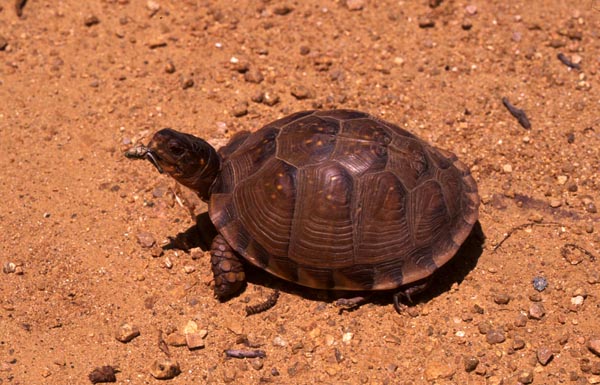
This photograph was taken in July 2000 in Johnston County, OK, near Reagan.

This photograph was taken in July 2000 in Johnston County, OK, near Reagan.
The three-toed box turtle, Terrapene carolina triunguis, is a common terrestrial turtle in the south-central part of the US, from Missouri in the north, through all of Arkansas and most of Louisiana, into Mississippi and parts of Alabama in the east, to eastern Kansas, eastern Oklahoma, and north-central and east Texas in the west. This turtle prefers woodlands to open prairies (where the Ornate box turtle is more common). TTBTs are omnivorous and feed on fruits, berries, mushrooms, insects (the one above is eating a grasshopper), and various small vertebrate prey including carrion.
Turtles appear in the fossil record about 210 mybp, during the late Triassic period. The first turtles are fully formed and have morphological features similar to those of modern turtles, which include a shell that consists of an upper "carapace" and a lower "plastron", which are connected by lateral "bridges". The plastron of most terrestrial turtles has hinges so that the shell can be closed tightly. The shell is well developed in land turtles and tortoises, but is frequently reduced in aquatic species, especially the freshwater softshell turtles and some of the marine species.
TTBTs spend the winter in burrows or crevices where they are protected from the cold. They emerge in the spring and typically mate soon after emerging. Courtship (described by Collins, 1974) includes visual displays by the male, and tactile stimulation of the female. Males have bright orange patches on their throat and front legs, as well as orange eyes, and presumably the displays are designed to show these features off during courtship. Males use the long claws of the hind feet to stimulate the female after mounting and during copulation. Females dig a shallow hole in sandy or loose soil and lay 3-8 eggs. The eggs hatch in about three months, so typically in mid to late summer. The hatchlings are only 2-3 centimeters long, but have the same coloration and shape as the adults which are 10-12 cm long. Because TTBTs (and other land turtles) are frequently kept as "pets", there is substantial information about their longevity, at least for those in captivity, where lifespans of 40 years or more are common, and there are records of a century or more.
In addition to the TTBT, there are three other subspecies of Terrapene carolina. These are the eastern box turtle, the Florida box turtle, and the gulf coast box turtle. These three subspecies have more or less discrete distributions (e.g. their geographic ranges do not overlap), and there are a variety of characteristics in which the three subspecies differ from one another, for instance number of toes on the hind foot (the TTBT usually has three and the others have four, but sometimes individuals of the TTBT have four and sometimes individuals of the other subspecies have three), and color pattern on the carapace (although there is considerable variation among individuals within the four subspecies, and much overlap in coloration between the subspecies). The characteristics that separate the subspecies tend to be less distinct where the ranges of the subspecies are adjacent or overlapping.
What is the significance of all of this geographic and individual variation?
The geographic variation (and division into four subspecies) is presumably
at least partly due to different selection pressures in the different parts
of the range of this species, so that different populations have responded
with different adaptations that are appropriate for their environment.
The response of the populations to different selection pressures is possible
because of variation among individuals within these populations in characteristics
that affect survival and reproductive success. These characteristics are
also assumed to be at least partially heritable (controlled genetically)
so that offspring resemble their parents. Characteristics that affect survival
and reproduction are passed from parents to offspring, and those that have
a positive effect on reproductive success tend to become more prevalent
in a population over evolutionary time, while those characteristics that
have a negative effect on reproduction tend to disappear from populations.
The result is that populations are well adapted to their particular environments.